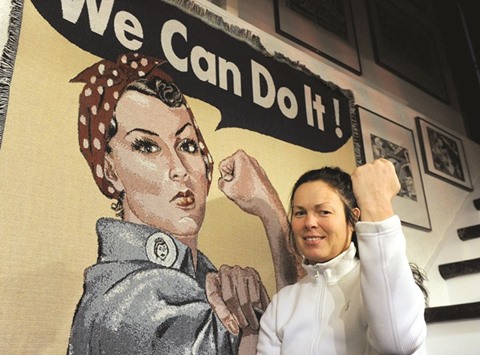“I’m an athlete, not an adventurer,” says Freya Hoffmeister. But the journeys the extreme paddler undertakes are nothing if not adventurous – and dangerous.
Paddling across the estuary of the Amazon in South America on one expedition she was “washed out” of her canoe by the “pororoca,” a tidal wave that can reach heights of 5 metres, race at speeds of up to 65 kilometres per hour and can travel up to 800 kilometres upriver.
Rounding Cape Horn in southern Chile, she battled 4-metre-high waves and gale-force winds that threatened to drive her down to the Antarctic.
The 52-year-old German has covered more than 50,000 kilometres in her sea kayak on her many expeditions – using, of course, just her arms – but her next journey will top them all.
In March she’s planning to begin circumnavigating the North American continent – another 50,000 kilometres.
She has reckoned with spending about eight to ten years on the adventure, “but it could become 12, depending on my personal circumstances and on my physical condition.”
If she achieves her goal, she’ll be just over 60. “I don’t know if my ageing body will cope with the challenge but I think so,” she says, with a coquettish laugh.
“I only like doing things that not many people do or can do,” she adds.
Travelling the length of the North American coastline isn’t the first extreme journey Hoffmeister has been on.
In 2007 she spent 33 days circumnavigating Iceland, and in 2009 she paddled around Australia in record time; it took her 11 months to travel the 18,000 kilometres.
She became the first person ever to circumnavigate South America by kayak in 2015, a 27,000-kilometre trip via the coasts of 13 countries which took her 30 months.
The coast of North America has never been completely circumnavigated by someone in a kayak either. Hoffmeister plans to divide the journey into two, starting both times in Seattle and ending in New York, first clockwise and then anti-clockwise.
She’ll paddle southwards for half of the year’s trip time and northwards for the other half.
“The northern parts are only free of ice for a couple of months a year. If I only paddled in one direction the circumnavigation would take years longer,” she says.
Of course the journey could be done faster, she says, “But I’m not an ambitious sprint athlete, I want to enjoy the scenery.”
Fully loaded with equipment and food, her kayak weighs about 100 kilograms, which means her speed is about walking pace.
Hoffmeister has divided the journey up into blocks of three to five months. In between she’ll return to her home town of Husum, a port town in northern Germany just over the border from Denmark.
“I’ve got a partner, a son and two businesses I have to look after,” she says.
Though she’s well versed in the dangers presented by her line of adventuring, the trip round North America has its own particular challenges, especially on the northern half.
“(There will be) bears of all colours; black, brown, grizzly and white polar bears – that one’s particularly nasty.”
But she says she’s not afraid. “Then I would never set off. Fear makes you into a victim and I don’t want to be a victim.”
Further south she expects it to be “business as usual – I’m not so worried about it.”
“I’ve an innate mental strength and success hasn’t made me weaker,” says Hoffmeister. “Even apparent ‘failures’ I turn around to make them into successes,” she adds.
That means, for example, not being downcast if you don’t arrive at your planned destination for the day.
“Then you arrive the next day and you’re happy that you’ve got something to tell – it would be a boring story if nothing had happened.” –DPA

52-year-old Freya Hoffmeister, from Germany, has covered more than 50,000 kilometres in her sea kayak on her many expeditions. In March, she will begin her attempt to circumnavigate North America.
